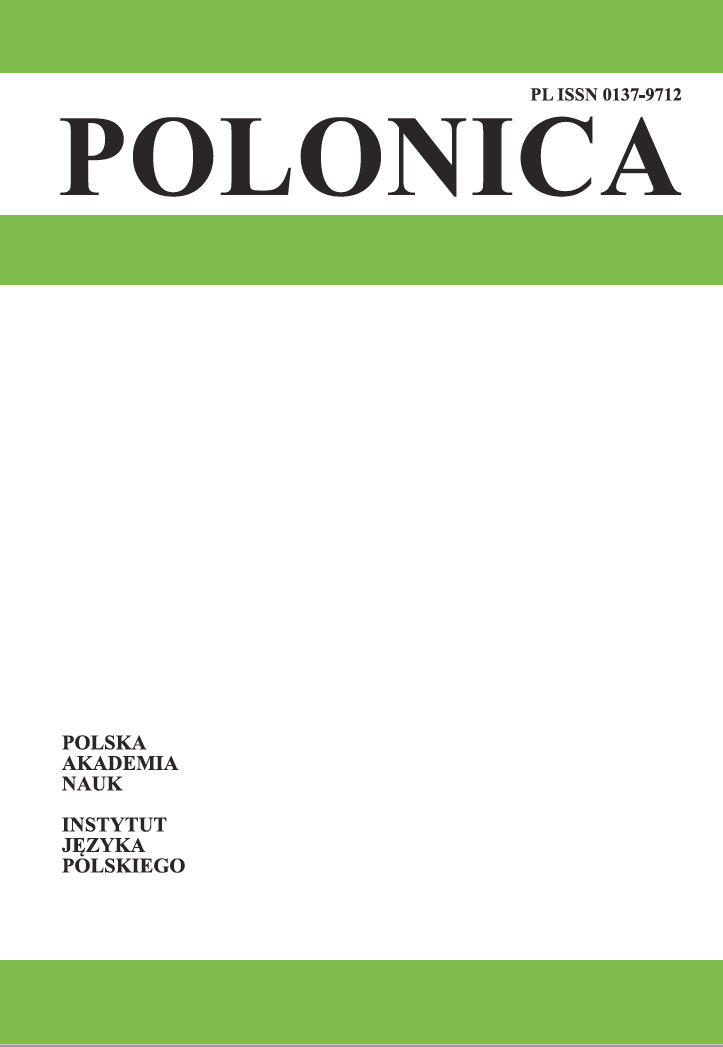Abstract
The purpose of the Grammatical Dictionary of Polish (sgjp.pl) in regard to inflection is to work out exact paradigms of all inflected lexemes of modern written Polish. These have been established for the most part in the previous versions of the Dictionary. The aim of the online edition of the Dictionary, its latest iteration, was to set up clear and easy-to-understand symbols for the inflectional patterns. Laying the groundwork, we analyzed a number of regularly contrasted written forms, which we then grouped into lexemes. A wordform consists of a core, common to all wordforms belonging to a lexeme, and an end (these parts are fixed graphically and do not correspond to traditional terms: stem and ending). Lexemes are grouped into classes (these correspond roughly to traditional parts of speech). Lexemes in a class share similarities in their inflection, and thus paradigms. Classes are categorized into inflectional patterns. Lexemes categorized under the same inflectional pattern have identical end in all wordforms. There are 6 general types of inflectional patterns: nominal, pronominal, adjectival, numeral, verbal and prepositional. Each inflectional pattern has its unique symbol. Each symbol consists of three parts. The first part is a letter, which denotes the general type of the inflectional pattern. The second part of the symbol is a sub-type of an inflectional pattern. The third part of a symbol shows alternations and non-standard phenomena in the paradigm of a given lexeme.
References
Gruszczyński W., 1989, Fleksja rzeczowników pospolitych we współczesnej polszczyźnie pisanej, Wrocław.
Gruszczyński W., 2001, Rzeczowniki w słowniku gramatycznym współczesnego języka polskiego, [w:] Nie bez znaczenia... Prace ofiarowane Profesorowi Zygmuntowi Saloniemu z okazji jubileuszu 15 000 dni pracy naukowej, red. W. Gruszczyński, U. Andrejewicz, M. Bańko, D. Kopcińska, Białystok, s. 99–116.
Gruszczyński W., Saloni Z., 2006, Notowanie informacji o odmianie rzeczowników w projektowanym „Słowniku gramatycznym języka polskiego”, [w:] Od fonemu do zdania. Prace dedykowane Profesorowi Romanowi Laskowskiemu, red. I. Bobrowski, K. Kowalik, Kraków, s. 203–213.
Saloni Z., 1992, Rygorystyczny opis polskiej deklinacji przymiotnikowej, [w:] Zeszyty Naukowe Wydziału Humanistycznego Uniwersytetu Gdańskiego. Prace Językoznawcze, t. 16, Gdańsk, s. 215–228.
Saloni Z., 2001, Czasownik polski, Warszawa.
Saloni Z., 2008, Les modèles de conjugaison des verbes polonais, [w:] Questions de linguistique slave. Études offertes à Marguerite Guiraud-Weber, réunies par R. Roudet et Ch. Zaremba. Aix-en-Provence; s. 279–292.
SGJP 2007: Saloni Z., Gruszczyński W., Woliński M., Wołosz R., Słownik gramatyczny języka polskiego. Warszawa. [płyta CD + broszura, s. 177].
SGJP 2012: Saloni Z., Woliński M., Wołosz R., Gruszczyński W., Skowrońska D., Słownik gramatyczny języka polskiego, wyd. 2, poprawione i uzupełnione, Warszawa. [płyta CD + broszura, s.~179, 2 nlb.].
SJPDor. 1958–1969: Słownik języka polskiego, red. W. Doroszewski, t. 1–11, Warszawa.
Skowrońska D., 2011: Makowska D., Formy deprecjatywne w „Słowniku gramatycznym języka polskiego”. Stan obecny i postulaty, Polonica XXIX, s. 205–226.
Tokarski J., 1951, Czasowniki polskie, Warszawa
Tokarski J., 1958, Formy fleksyjne, [w:] SJPDor., t. 1, s. XLIX–LXXIV.
Tokarski J., 1973, Fleksja polska, Warszawa.
Tokarski J., 1993, Schematyczny indeks a tergo polskich form wyrazowych, red. Z. Saloni, wyd. 2 – 2002, Warszawa.
